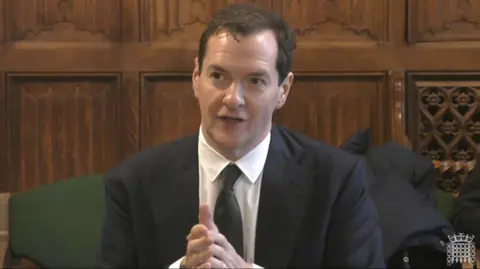British Museum was victim of inside job, George Osborne says
The British Museum was "the victim of an inside job" when a string of items were stolen, the chair of trustees George Osborne has said.
Around 2,000 treasures are thought to have been taken from the British Museum, but 350 have been recovered so far.
A staff member at the museum suspected of involvement in the thefts was sacked earlier this year.
The museum has now announced plans to digitise its collection.
Mr Osborne told Wednesday's session of the Culture, Media and Sport (CMS) Committee: "We were the victims of an inside job by someone, we believe, who over a long period of time was stealing from the museum and the museum put trust in.
"There are lots of lessons to be learnt as a result of that, the member of staff has been dismissed by us. The objects have started to be recovered."
He added: "We have changed our whistleblowing code, changed our policy on thefts... tightened up security on thefts."
Sir Mark Jones, the museum's interim director, said the decision to digitise the museum's collection would "improve security" following the thefts.
The museum said the project would take five years, and means the entire collection would be accessible online to anyone who wanted to explore it.
"We are now confident that a theft of this kind can never happen again," Sir Mark added.
 PA Media
PA MediaThe museum's former director Hartwig Fischer previously stepped down after accepting a 2021 investigation into the thefts was mishandled.
Sir Mark said: "We cannot and must not assume that the security of the collection, in a wider sense, can be achieved simply by locking everything away. It is my belief that the single most important response to the thefts is to increase access, because the better a collection is known - and the more it is used - the sooner any absences are noticed.
"So that's why, rather than locking the collection away, we want to make it the most enjoyed, used and seen in the world.
He added the process of digitising would be a "big task", with 2.4 million records to upload or upgrade. But, he said: "More than half is already done and when it is finished it will mean that everyone, no matter where in the world they live, will be able to see everything we have - and use this amazing resource in a myriad of ways."
The museum, one of the UK's most prestigious cultural institutions, has been under pressure since revealing in August that a number of treasures were reported "missing, stolen or damaged".
The items involved dated from the 15th Century BC to the 19th Century AD and had been kept primarily for academic and research purposes.
The museum has also announced plans for enhanced access to study rooms, where members of the public and academics can see additional items from the collection by appointment.
Speaking to the CMS Committee, Mr Osborne said: "We are intending to put on display the objects we have recovered, there is a lot of public interest in these objects.
"Three-hundred-and-fifty have now been recovered and titles have been transferred to us so we have the makings of a good exhibition that was not previously planned."
Asked about the steps the museum has taken to stop something similar happening in the future, Sir Mark told MPs: "We have changed the rules governing access to strong rooms, now there is nobody who is allowed to go into a strong room on their own and that, with a whole lot of other measures, should ensure that kind of theft that has happened couldn't happen again.
He also said the nature of the case was unusual, commenting: "I did used to work in the British Museum and I think this particular cache of unregistered material is completely exceptional."

The story has been deeply damaging to the institution.
How could 2,000 items go missing without anyone inside the museum apparently noticing?
This isn't only about theft, it's also about the perception of complacency or worse; warnings that went unheeded. Gem dealer Ittai Gradel flagged his suspicions to the museum authorities and was brushed off.
The only way forward is openness and transparency. Hence the announcement today that the museum will get its entire collection online in five years and will increase access to items that aren't on display.
There's a long way to go still. There's an ongoing police investigation. The British Museum's external review of what went wrong is likely to report later this year.
And the recovery of items is vital - 350 are in the process of being returned. That's around one sixth of the total - what has happened to the others?
The select committee was an opportunity for transparency and the institution's leaders, George Osborne as chair of Trustees and Sir Mark Jones, the new interim director, were candid.
Mr Osborne also revealed publicly his thoughts on the fate of the Parthenon Sculptures (traditionally known in the UK as the Elgin Marbles).
He said he's exploring whether there is "some kind of arrangement" that would allow some of the sculptures to spend some of their time in Greece. Effectively a temporary loan in return for Greek objects that haven't been seen in the UK before.
He talked of a "proper partnership" where objects from Greece would come to the UK and objects from the Parthenon collection could potentially go to Greece.
He conceded the stand off between the two nations is "not an easy problem to solve and we may not succeed, but it's worth seeing if we can find a way through".
